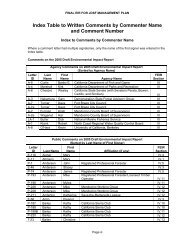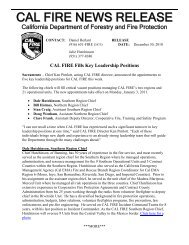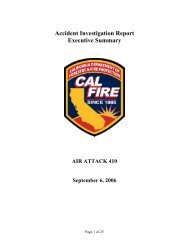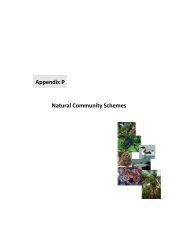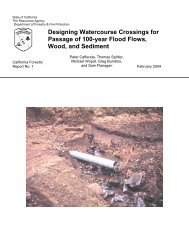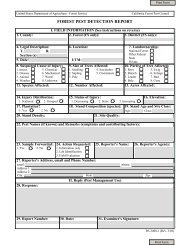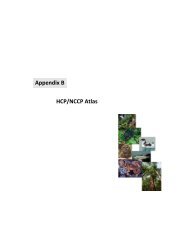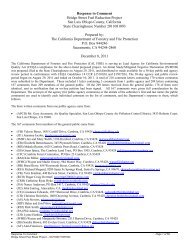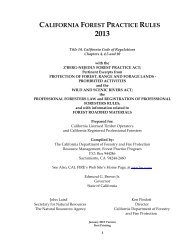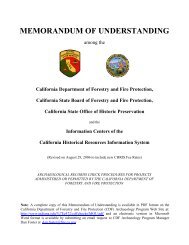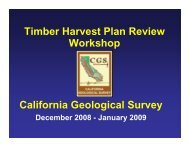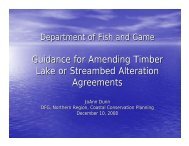Boggs Mountain Demonstration State Forest Draft ... - Cal Fire
Boggs Mountain Demonstration State Forest Draft ... - Cal Fire
Boggs Mountain Demonstration State Forest Draft ... - Cal Fire
You also want an ePaper? Increase the reach of your titles
YUMPU automatically turns print PDFs into web optimized ePapers that Google loves.
<strong>Boggs</strong> <strong>Mountain</strong> <strong>Demonstration</strong> <strong>State</strong> <strong>Forest</strong> <strong>Draft</strong> Management Plan, June 2008<br />
ii If firewood from host material is being removed from the site for commercial or private use, a<br />
compliance agreement must be in place in addition to the required firewood permit. The<br />
information as to where and what is being removed, how it will be transported, specifically where<br />
it will be moved to, and during what time period, should be included in the harvest plan if the plan<br />
will act as the compliance agreement. If this information is not included in the plan, a separate<br />
compliance agreement will be necessary prior to movement of host material.<br />
iii In the regulated area, the collection of minor special forest products that are known host plants<br />
will be restricted to areas where the "free-from" protocol has been implemented, or where a<br />
compliance agreement is in place.<br />
3. Should SOD be identified on BMDSF lands, Management Practices to minimize the unintended<br />
movement of host material from infested areas include:<br />
a. The RPF will inform personnel that they are working in an SOD-infested area, unauthorized<br />
movement of plant material is prohibited, and the intent of the mitigation measures is to prevent<br />
disease spread (914 CCR 1035.2).<br />
b. If some sites in the general operating area are found to be disease-free of have a low<br />
incidence of disease, initiate and complete operations on these sites before moving to more<br />
heavily infested sites.<br />
c. To the extent practical, locate landings, log decks, logging roads, tractor roads, and other sites<br />
of equipment activity away from host plants, especially areas with disease symptoms.<br />
d. Route equipment away from host plants and trees, especially areas with disease symptoms.<br />
e. The equipment or vehicles must be inspected for host plant debris (leaves, twigs, and<br />
branches each time equipment or vehicles leave the site. Host plant debris must be removed<br />
from the equipment and vehicles prior to their departure. This applies to all equipment and<br />
vehicles associated with the operation, including logging equipment, log-hauling trucks, pick-up<br />
trucks, employee's personal vehicles, etc. An exception will be granted for equipment or vehicles<br />
that leave the site temporarily and will not be traveling to uninfested areas prior to their return.<br />
f. In addition to following <strong>Cal</strong>ifornia Department of Fish and Game (CDFG) drafting guidelines<br />
(intake mesh size, etc.), water should not be drafted from a watercourse in a SOD-infected<br />
drainage and used in an uninfested area. This is because sporangia from infected leaves (or<br />
minute parts of infected leaves), themselves in the watercourse, could be suctioned in the draft<br />
and transported to new areas. Infection could be possible if abatement over-spraying landed on<br />
susceptible hosts.<br />
4. Management Practices to minimize the unintended movement of soil and host material from<br />
infested areas (these practices are not specifically required for operations on infested sites, but<br />
the RPF must state and justify what practices will be used to minimize the unintended movement<br />
of infested host material):<br />
a. The SOD fungus resides in soil and duff in infested areas and soil/duff is therefore a potential<br />
carrier of the disease. The greatest threat of disease spread occurs when wet soil is present. Soil<br />
movement should be addressed.<br />
b. Because wet soil and mud will readily adhere to vehicles, equipment, and boots: conduct<br />
operations during the dry season; utilize paved and rocked roads and landings to the extent<br />
possible.<br />
c. After working in an infested area, remove or wash off accumulations of soil, mud, and organic<br />
debris from shoes, boots, vehicles and heavy equipment, etc. before traveling to an area that is<br />
90



